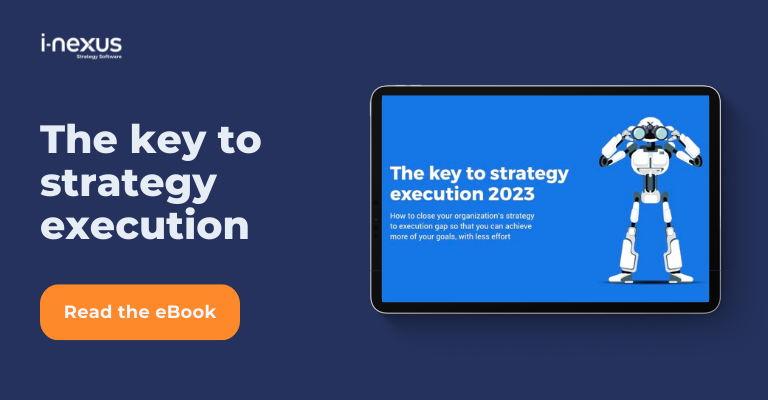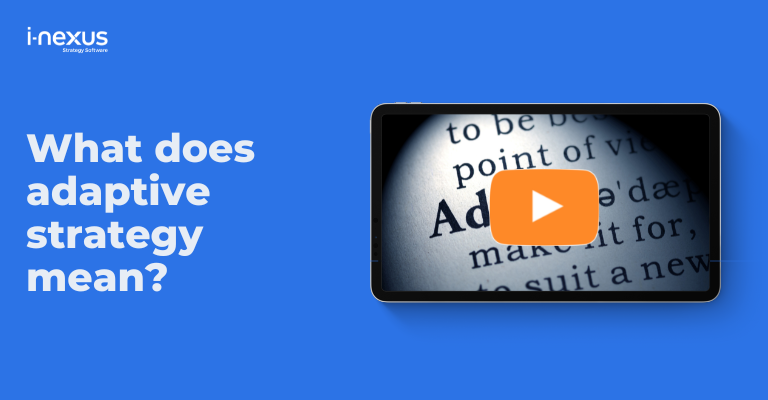Delivering on your strategic goals is nothing short of challenging. When operations take up more than 80% of your time, how do you keep focused on making your long-term goals a reality? Here are 11 reasons why it's not as easy as it looks.
Written by: James Milsom, Head of Marketing
When you stop to consider the list of skills and disciplines involved with Strategy Execution Management it is easy to understand why failure is a common outcome.
Portfolio management allow requires dexterity and critical thinking to balance competing priorities and resources. Program management requires executing your plans successfully to ensure it is your program and your stakeholders who are met with success.
So is it any wonder that 71% of strategic programs fail (McKinsey)?
For Strategy Execution is not purely watching your initiatives and project mix come to life. Not at all. It really concerns itself with a handful of issues:
- Leadership
- Resources
- Strategic formulation
- Engagement
- Project portfolios
- Technology
- Data
The management aspect of strategy is about the delicate balancing act that is required to pass a vision into existence – strategic formulation and planning, strategic implementation and then strategy execution.
Over or underestimating the importance of any stage in this lifecycle must be done with the failure rates reported by McKinsey firmly in mind.
From the allure of theory to lack of engagement and executing strategy at scale, here are 11 reasons why you’re finding Strategy Execution Management challenging.
1. The allure of theory
“Strategy is a commodity, execution is an art”
Peter Drucker
There are few places better to begin our list of challenges than with Peter Drucker.
Drucker perfectly captured the zeitgeist of the post-war management mindset.
Great works of theory were captured and released after World War Two. Whether it’s Lean Management or Hoshin Kanri, the sheer volume of theory that came to the attention of managers across the world was staggering.
What this didn’t come with was practical advice, or cautionary tales.
Giants such as Google champion OKR, Ford put Lean on a pedestal and Danaher are synonymous with Hoshin Kanri, but the reason for their success is the attention given to the process of Strategy Execution.
Indeed, we have argued that there is little difference when it comes to strategic theories:
- Hoshin v OGSM v OKR
- Hoshin Kanri v 4DX v MBO
- Hoshin Kanri and Balanced Scorecard
- PDCA, Lean and Agile Thinking
Instead of agonizing over the correct theory for your strategy we implore action.
Avoid over-thinking which framework is best for your organization.
2. Policy and strategy misalignment
There is a prevailing mindset that business policy and strategy are one and the same. They are not.
Your business policy refers to the guiding principles for your management team, and indeed entire business, when it comes to operational management, typically.
However, applying a more strategic lens to business policy reveals a secondary purpose – it offers a raison d'etre which bleeds into your strategy.
If your strategic direction, implementation and execution fly in the face of your business policy, you will be increasingly likely to fall into the trap of the proceeding challenges of Strategy Execution Management.
For example, your business policy, based on ethically sourcing materials, must align to your strategic objectives of decreasing logistical costs.
If you were to source a distributor who doesn’t have a green-first environmental mindset, or has been linked to questionable working conditions, this is misaligned to your business policy.
3. Ignoring the importance of strategic implementation
When we embark on a journey to learn a new skill, increase our muscle strength or some other milestone, we do so knowing that there are things we must do once we have set goals.
Those ‘things we must do’ speak to the implementation phase of Strategy Execution Management.
Please do not believe that you can set a strategic direction and move straight to execution.
Strategic implementation is the lost art of shepherding resource, securing employee engagement and ultimately laying out processes and systems to help you execute your strategy.
Without these in place your strategy will fall into that 70% failure rate with great ease. Why? Because a strategy is simply a piece of paper. Implementation sees your strategy flow into the planning phase, ready for successful execution.
Ignore the importance of strategic implementation at your peril.
4. Lack of engagement
Engagement is an element of Strategy Execution Management which can be easily brushed to the wayside.
The reason is that engagement adds a further delay, you may argue, between setting your strategy and seeing results.
The logic being that by asking your senior managers and key stakeholders to weigh in on your objectives and project portfolio mix you could add another two-three months to the process.
But engagement goes beyond the formulation and implementation phase. Have you put the necessary thought into how you communicate your initiatives?
How will you select teams to execute projects? What rewards are in place, and have you consulted your organization on what they feel is a just-reward?
Don’t play to the stereotype of strategy being created behind closed doors and then pushed downwards upon your staff.
5. No employee buy-in
Employee buy-in does not refer to every individual in your organization giving their blessing to your strategy and the resulting initiatives and work.
Naturally, your employees will be resistant to some elements of your strategy, namely where change is involved. Others will automatically toe the line.
What you should be certain of is working with your management team to explore chains of feedback. For example, a catchball technique allows a reasonable number of your employees to be involved in objectives formulation.
Buy-in is a signal of approval from your organization that they support your vision and can understand the value of what is being asked. Engaged, supportive employees are those who will want successful for all.
6. Your knowledge holders leave
Traditionally, knowledge has been held across organizational structures in unassuming, hidden pockets.
Those pockets have several Achilles – whether that is relying on outdated technology to execute strategy which requires complicated formulae, or there are a handful of people who hold institutional knowledge, uneasy to replicate.
The consequences can derail your Strategy Execution.
Putting in place learning techniques such as shadowing and a central database for internal knowledge will mean that your strategy stays on-track, regardless of personnel incapacity.
7. Leadership commitment
Leadership requires living and breathing your strategy. Whether you sit as the c-suite level or are a unit manager, it is for management to set examples.
That could be hosting roadshow events to review progress on the shop floor, regularly broadcast emails or a mechanism to share ideas and see those through to implementation.
Don’t fall into the trap of introducing new systems, technologies and ways of working which you fundamentally disagree with or would not use yourself. Show your organization your commitment to the cause and it will inspire the rest to follow.
8. Executing at scale
Much could be said for Strategy Execution failing because of scale.
Sometimes it is best to consider rolling out strategy within a division or territory instead of doing so on a global scale. There is an argument for functions such as IT to be centralized, but does that apply in every instance?
Should you formulate, implement and execute a strategy within a division or territory you can have greater control over the successes and failures of its management.
That information gathering will allow you to tweak and then, ultimately, roll this out at scale.
9. Gut over data
We’ve written before about choosing data over instinct and those arguments still hold weight. I would encourage you to revisit that blog.
The reason that we choose our gut above all else is something so deeply embedded into our DNA through our ancestors’ fear of danger that it can seem almost impossible to ignore our better intuition.
However, with a wealth of data at your fingertips – projects, KPIs, metrics and dashboards which bring your execution to life wherever you are, there is little mystery to be had as to strategic decision making.
10. Your IT team
A bold statement, but IT teams are at the heart of your Strategy Execution Management. It is through this team you rely on the correct systems to implement, track and execute your vision.
Additionally, there is a tendency for IT to avoid adding another software platform, even if it were to present benefits for Strategy Execution.
In fact, there is a likelihood they choose to build internally – so consider this:
- 55% of IT professionals cited projects fail because of lack of time
- 39% of IT professionals have an unhealthy work-life balance spurred on by COVID-19 and the complications of providing basic support to remote workers (CV Library, 2020)
Your IT team is under considerable pressure, therefore helping them to support your Strategy Execution is a key part of managing the entire life of your cycle. You can do this by being sure of your resource needs, including technology.
11. Technology
Cloud computing (i.e. software) is growing exponentially.
That presents more opportunities to re-evaluate the systems and processes you have in place to execute your strategy.
That could be investing in Microsoft Teams to enable your business to maintain execution and expected performance in the face of changing working conditions (see COVID-19).
Alternatively, it could be adopting Internet of Things technology to introducing new machinery into your plant to help decrease your defects per million opportunities.
And, in the case of your Strategy Execution Management, it means harnessing the power of software from vendors such as i-nexus to connect your operation management, continuous improvement programs and transformation project portfolios – all the elements required for your successful execution.
Moving forward with Strategy Execution Management
Strategy Execution Management need not remain challenging to your and your organization. While these have been 11 reasons you may be struggling, they do offer hope and ways forward.
What's next? Click here to visit our Strategy Execution Management knowledge hub, filled with content to support you in embracing the 'no normal' of strategy in the 2020s and beyond, or explore these recommendations:
- Assessing organizational capabilities: How do I know my goals will be delivered? Explore the importance of an organizational capabilities profile when it comes to executing your strategy.
- How AI and machine-assisted learning will help your Strategy Execution: As Artificial Intelligence becomes a mainstay in our lives, read how AI and machine-assisted learning will evolve to support your Strategy Execution.
- Download our Key to Strategy Execution eBook: Read how companies like Danaher and HP have mastered Strategy Execution Management and what you can learn from them.
About the author
James Milsom is Head of Marketing at i-nexus. James has wide-ranging experience of markets such as telecommunications, energy, education and software.
As Head of Marketing, his drive is to raise awareness and understanding of the challenges facing enterprises in delivering strategic objectives and transformation amidst changing markets and the obstacles traditional tools and methods present leaders.
If you’d like to talk more about Strategy Execution, reach out to James on james.milsom@i-nexus.com or connect with him on LinkedIn for the latest insights.




